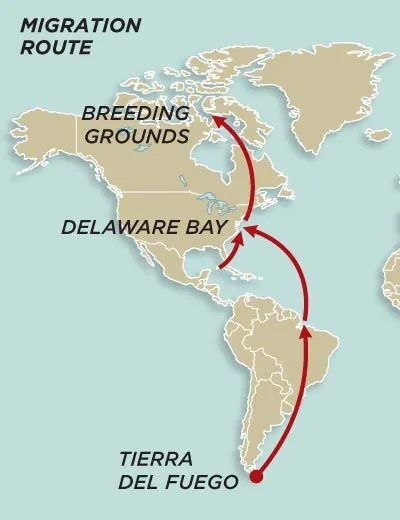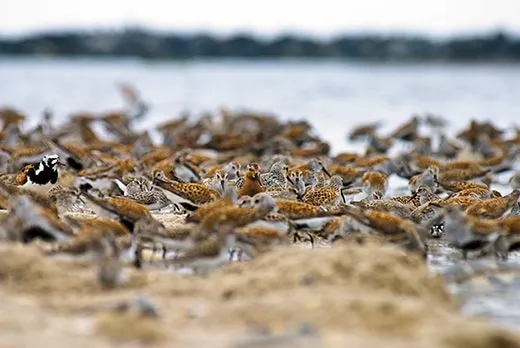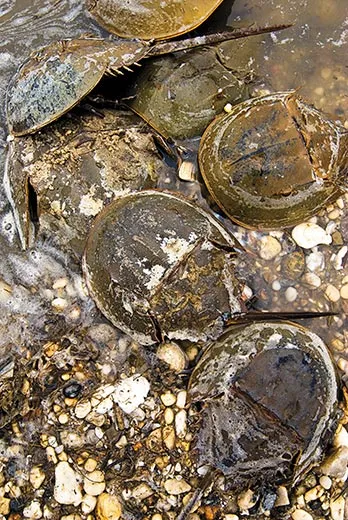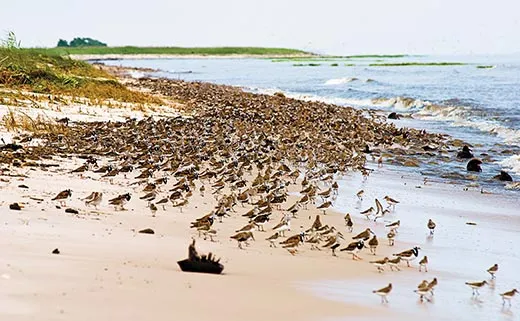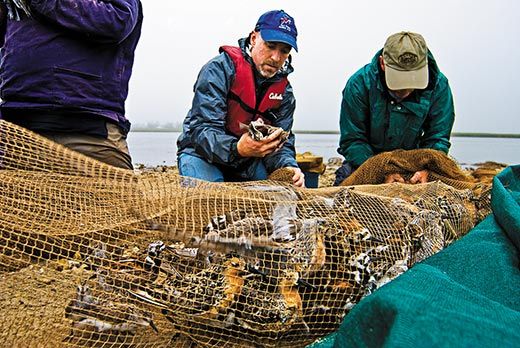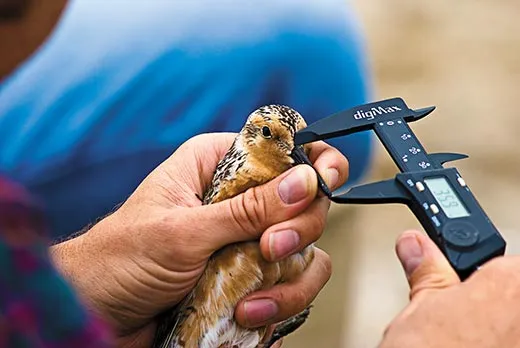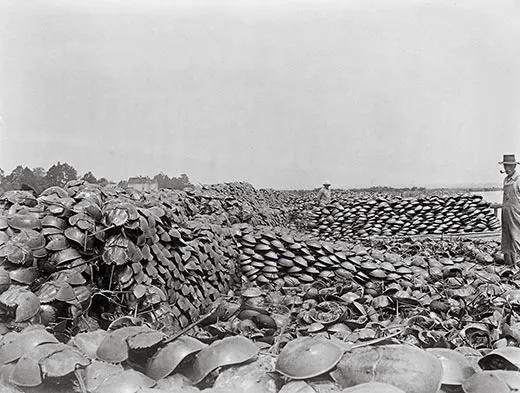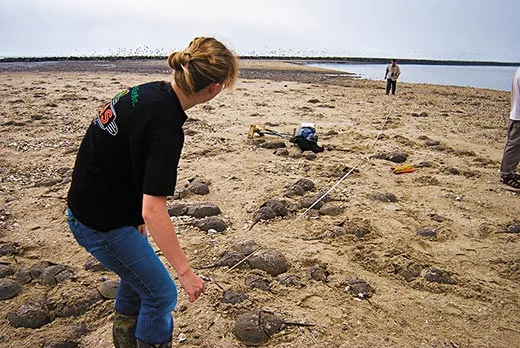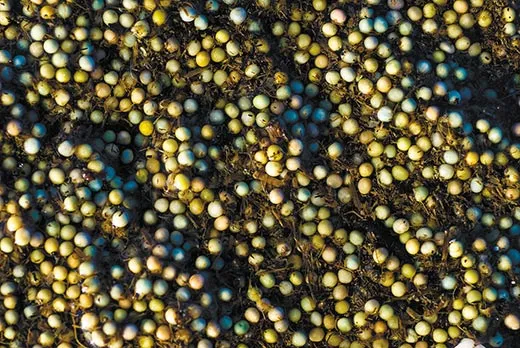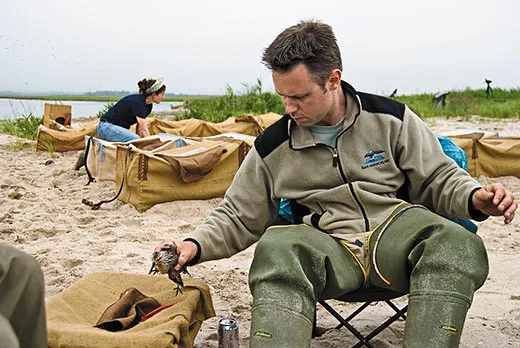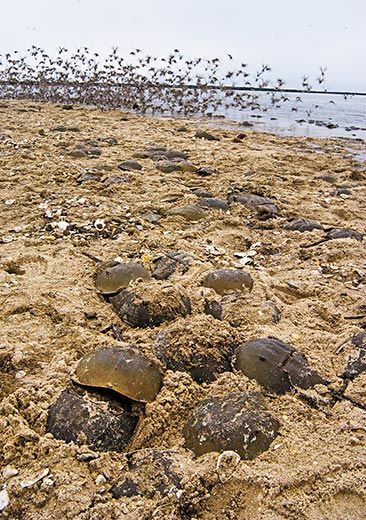Return of the Sandpiper
Thanks to the Delaware Bay’s horseshoe crabs, the tide may be turning for an imperiled shorebird
/https://tf-cmsv2-smithsonianmag-media.s3.amazonaws.com/filer/red-knots-Delaware-Bay-631.jpg)
The horseshoe crabs come from the deep, summoned by the big spring tides. Plodding and clumsy, the crabs plow along the continental shelf and through the silty waters of Delaware Bay, then drag themselves onto beaches to lay their eggs—with occasional detours to boat launches and coastal roads and waterfront parking lots. Easily flipped by waves or stranded by retreating surf, their bodies litter the shoreline like rusting artillery from a forgotten war. But their tails tick back and forth in the sand, like metronomes. They only look dead.
The red knots descend from the sky. Plain, stocky sandpipers, they can fly a distance equivalent to a trip to the moon and back over the course of their lifetimes. They exude a twitchy, almost manic energy. Many have come from Tierra del Fuego, at the tip of South America. After a brief rest in Brazil, they travel almost 5,000 miles straight to Delaware Bay on the way to their Arctic nesting grounds. Upon arrival in the bay, they are basically starving, their breastbones protruding from their downy red chests.
Each May, the birds and the crabs meet on the beach.
It's a vital rendezvous. The emaciated red knots, in the midst of one of the world's longest migrations, have two weeks to double their body weight for the nonstop flight over Canada's vast forests to the polar tundra where they breed. Luckily, Delaware Bay's beaches are the site of the world's largest horseshoe crab spawning, which has historically generated a superabundance of fat- and protein-packed eggs.
Whole conga lines of crabs assemble at high tide, females as big as dinner plates tailed by salad-plate- and saucer-size suitors. The females dig holes in the sand and deposit sticky piles of wasabi-colored specks, which the males fertilize in the nest. Because there are so many crabs, they often kick up each other's nests, bringing the eggs to the surface.
Exposed eggs are no longer viable, but they still support life. The tiny red knots gobble some 25,000 eggs a day apiece—something like a person eating 700 chicken eggs in 24 hours—and so undergo one of the most rapid weight gains of all animals. By the end of their fortnight layover, some birds achieve outright corpulence, their breasts swaying pendulously with every step. When the restless flocks finally sound their departure calls in late May or early June, the fattest individuals sometimes struggle to achieve lift-off.
The Delaware estuary is considered one of the most important shorebird stopover zones in the world, largely because of the supply of horseshoe crab eggs. But lately red knots and other migratory species have been having trouble gaining even the minimum weight necessary to continue their journeys. Since the mid-1980s, the number of visiting red knots, once close to 100,000, has fallen by more than 75 percent, to fewer than 25,000.
Scientists blame the decline on the harvest of horseshoe crabs for fishing bait, a practice that increased an estimated twenty-fold in the 1990s. States along the Atlantic Coast have since halted or restricted the harvest, and the crabs are now showing preliminary signs of recovery. For the birds, it's not as clear. In 2003, the knots were so thin they simply lacked the energy to reach the Arctic; they stopped in southern Canada and skipped an entire breeding cycle. About 15,000 passed through Delaware Bay that year, and the numbers haven't improved much since. Some scientists have forecast the imminent extinction of the rufa red knots (Calidris canutus rufa), the most common North American subspecies, which have historically relied on the crabs to refuel.
And so these days a third species flocks to Delaware and New Jersey's marshy shores: concerned ornithologists and birders from all over the world, armed with tagging gear, cannon nets, tide charts, trays of vegetarian lasagna to keep their strength up and jumbo bottles of wine. Each spring they pitch tents on the beach or crash in rental houses, keeping vigil via telescope.
The morning fog that enfolded wooden pilings and moored boats in Mispillion Harbor also helped to hide several dozen men and women crouched behind scraggly bushes. The stretch of sand before them gradually darkened as shorebirds—ruddy turnstones, semipalmated sandpipers and plenty of red knots—touched down and began jackhammering for eggs. The knot's distinctive call—whit-whit!—was lost in the greedy din. Suddenly spooked ("It wasn't me!" someone hissed over the two-way radio), the big flock levitated for a moment and sank back down to the beach. Feasting resumed. "Get ready, base camp," the radio crackled.
Then: Boom! A miniature cannon on the beach spewed a net as big as a swimming pool cover over the birds, which, now trapped, bounced like microwave popcorn in a bag. The birders, most of whom were wearing unwieldy waders, stormed out of the mist and fell to their knees in the sand to start sorting the several hundred captured knots and other shorebirds, placing them in burlap-covered boxes, which they hustled up the beach. There, volunteers sat in circles of folding chairs, passing the birds around briskly: every second in captivity was costing the birds precious calories. The flocks had arrived en masse 11 days earlier and would be leaving for the Arctic soon.
"More knot, I need more knot!" a British ornithologist called out when her box was empty. Everyone, including (understandably) the birds, was quite frantic, and I was soon recruited to help. In my hands the knots felt frighteningly light, as though they had soda straws for bones. Imagining them flying from Tierra del Fuego seemed almost silly, like picturing a paper airplane reaching the stratosphere.
Some workers plucked breast feathers (for determining a bird's sex) and bits of wing feathers (chemical analysis can reveal where it spent the winter); others measured beak lengths or affixed colored tags. The legs of many knots were already bangled with multiple tags from ornithologists in other parts of the world: red for Chile, orange for Argentina, blue for Brazil and green for the United States. (Though all rufa red knots breed in Canada, they winter along the eastern coast of the Americas.) Most coveted of all were birds whose coded tags showed that they had been caught in Delaware just a few days earlier. These birds were inserted gently into tubes resembling toilet paper rolls, to keep them still, and placed on scales, to see exactly how many grams they'd gained. The rest of the birds were also weighed, to get a sense of how the flocks were faring. Many knots had arrived weighing less than 100 grams. Ideally they would weigh at least 180 grams by the time they left.
"Oh, I've got a really skinny one," said volunteer Richard du Feu softly, examining the scrawny knot in his hand. "This one almost certainly won't make it to the breeding grounds."
Yet many people expressed some optimism about the 2009 season. They've learned, after more than a decade of disappointing migrations, not to count their knots before they hatch, but the team had estimated an impressive 25,000 birds in a survey the night before—many more than usual. It's possible that some red knots shifted their migration route in past years to scrounge for food sources beyond the bay. If so, some of those birds may be back, perhaps because there has been mild weather and crab eggs aplenty so far. Then again, last year's spawning had seemed bountiful, too, until a Mother's Day storm cooled the water and the crabs stopped laying. "Birds arriving in the middle of May expecting crab eggs didn't get any," said Kevin Kalasz, who oversees the state-run Delaware Shorebird Project. The knots left for the Arctic a week late, still disastrously underfed.
As the captive birds were released one by one to resume pecking in the sand, the tide eased in and horseshoe crabs approached the shore, great masses of them turning like gears in the shallows. Soon there were so many crabs you could hear them moving through the water, a sound like a slow boil.
Delaware Bay's diminutive waves, temperate water and sandy beaches make it a haven for horseshoe crabs (Limulus polyphemus). They are rare outside of North America's Atlantic Coast, although there are other horseshoe crab species in Asia. The creatures predate the dinosaurs and, as part of a group called chelicerates, are closer cousins to spiders than to true crabs, which are crustaceans. Nigel Clark, a research scientist with the British Trust for Ornithology, whose T-shirt sported a glow-in-the-dark horseshoe crab, called their spring spawning "one of the world's great spectacles." Crabs in more southern waters spawn throughout the year, but in the chilly mid-Atlantic they are sluggish until the ocean starts to warm. When it reaches 56 degrees, it's time to storm the beaches. The spawning lasts from late spring into August, but the high point is the last new or full moon of May, when the tides are strongest; eggs laid at the high waterline are more protected from the surf.
Locals used to grind up horseshoe crabs for fertilizer or livestock feed. The crabs' commercial value rose in the early 1970s, when scientists realized that an extract of their copper-based blood, which is a lovely cornflower blue, could be used to test for toxins in injectable drugs and in medical devices such as pacemakers and syringes. (It contains a clotting agent that is hypersensitive to toxic bacteria.) Several companies currently run labs where captured crabs are bled of roughly a third of their blood, then sent back into the sea. Most crabs reportedly recover within a week, though some environmentalists claim that the mortality is likely higher than the 7 percent to 15 percent the companies estimate.
Then, in the 1980s, with stricter regulations on other catches, Delaware Bay fishermen entered the emerging Asian market for conch and eel. Horseshoe crabs, chopped and frozen, particularly the big, spawning-age females, made great bait. By the mid-1990s, nearly three million crabs were being caught each year along the Atlantic Coast. There were still a lot of crabs left—but not the critical density needed to kick up each other's nests, making eggs accessible to knots and other birds.
Largely out of concern for the birds, the Atlantic States Marine Fisheries Commission issued its first horseshoe crab harvest restrictions in 1998, and regulations have steadily tightened since. New Jersey currently has a moratorium on harvesting horseshoe crabs. Delaware limits the catch to 100,000 males taken outside the knot-migration season, and Maryland and Virginia have also cut back. Fishermen are finding ways to use fewer crabs as bait, and researchers are trying to develop an artificial bait to replace the crabs entirely.
Female crabs take ten years or more to mature, so the offspring of the first crabs spared after 1998 are only now ready to mate. Their presence might help explain the spectacular spawning this year.
Red knots—which can live ten years or longer—are also relatively slow to breed: though the 6-week-old chicks will flutter south after the brief Arctic summer, they won't be ready to migrate north and mate for two years.
There are also myriad dangers outside the bay area, which, after all, is just a tiny portion of the territory these birds cover. The knots are vulnerable to oil spills, late snowmelts in the Arctic and even lemming population trends; if the lemmings die off, northern predators devour shorebird chicks instead. "If everything's great in Delaware, something awful can happen in the Arctic," Clark said. But all these potential stresses make a reliable food supply at their main rest stop even more vital.
As tagging wrapped up, several military helicopters swooped low over the harbor. The birders wondered if the choppers were carrying dignitaries, maybe even the president, to Washington from nearby Dover Air Force base. This possibility did not diminish their outrage at the disturbance. Hundreds of birds that had resumed pecking nearby took off, making a soft rushing sound with their flickering wings, like wind through marsh grass.
They never came back. Or so it seemed. Few shorebirds resumed feeding on the point that morning, and later in the day volunteers checked all the usual beaches: no knots. Nor were birds sighted the next day, save a handful of portly stragglers. Unbeknownst to the birders, flocks had likely begun leaving the evening before the tagging, steadily flowing out of the region. This was a day and a half ahead of schedule: they had plumped up quickly.
It could be that the birds fared well simply because there were more horseshoe crab eggs to go around. Other shorebird populations have declined in recent years as well, freeing up even more eggs.
"We're not sure exactly why things went well this year," said Larry Niles, a biologist with the Conserve Wildlife Foundation of New Jersey. "Crab populations don't change that fast and neither do shorebirds." Still, he added, "it was really gratifying to watch the birds go off in good condition." And for days after the knots departed, crabs continued to crowd the shallows, waiting for the tide to change.
Abigail Tucker is the magazine's staff writer. Doug Gritzmacher is a wildlife photographer and videographer.
CORRECTION: A photo in the October issue of Smithsonian magazine showed a sandpiper taking flight. The bird was incorrectly identified as a red knot; it was in fact a short-billed dowitcher. The photo has been removed from the photo gallery to avoid further confusion.
